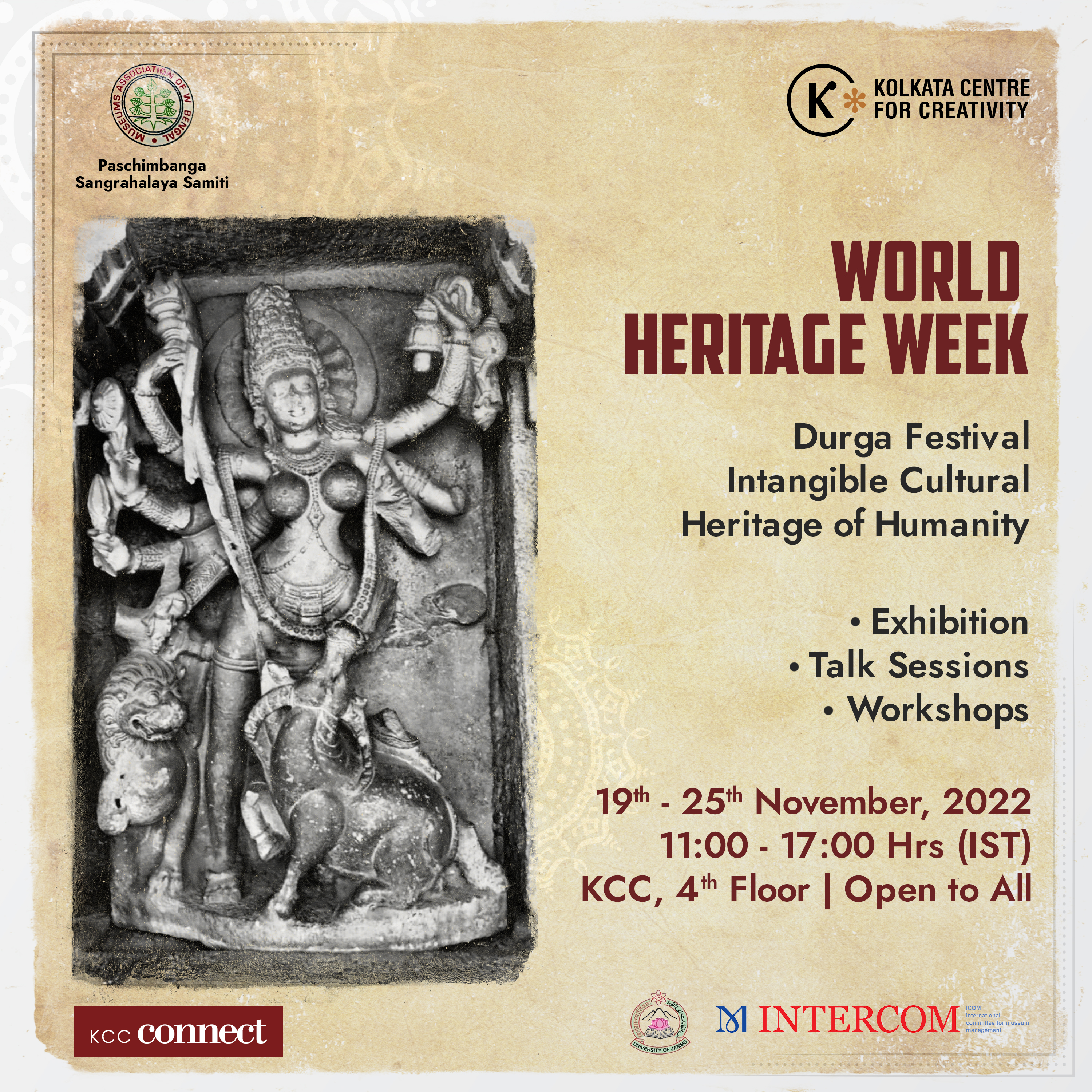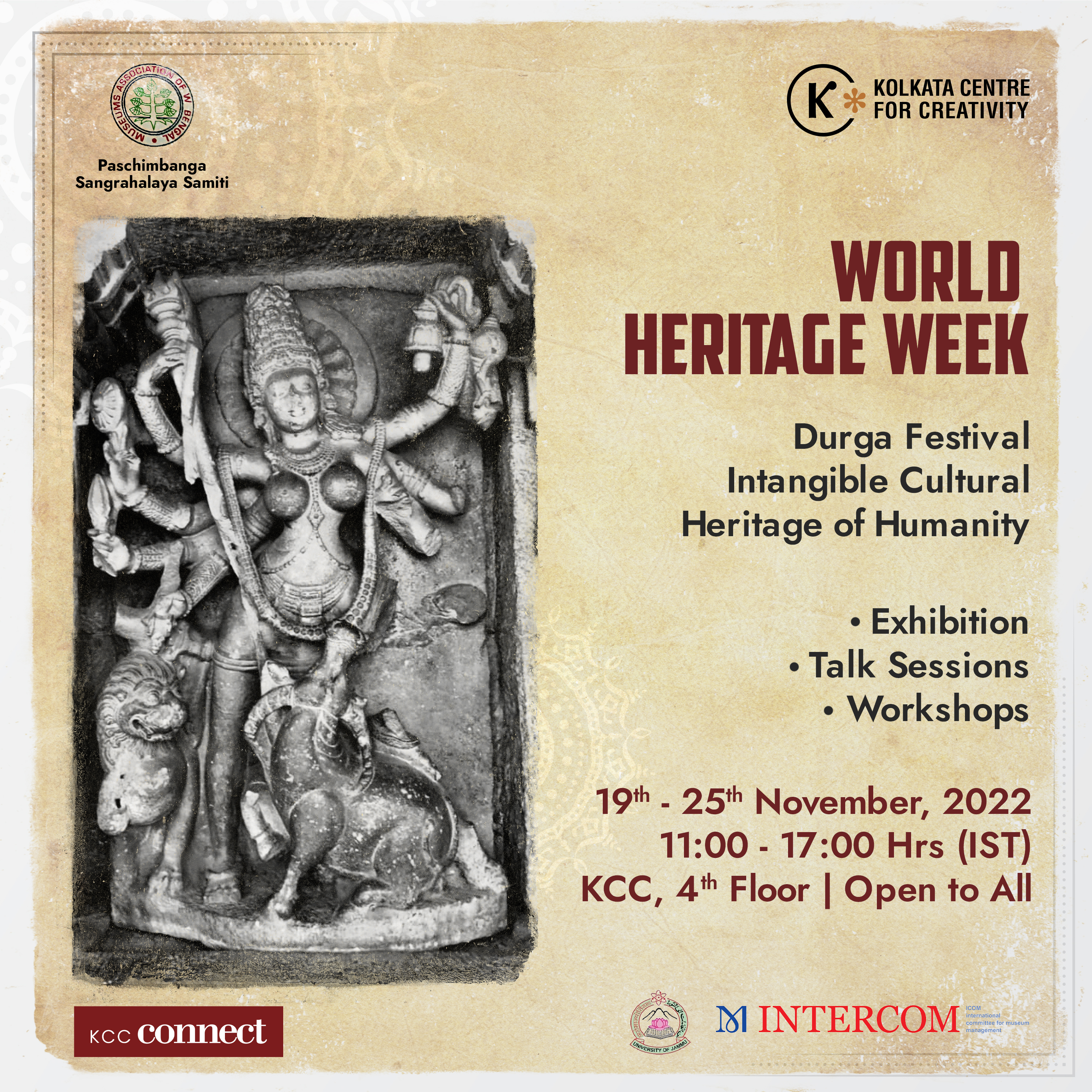WORLD HERITAGE WEEK: DURGA FESTIVAL- INTANGIBLE CULTURAL HERITAGE OF HUMANITY
The intangible cultural heritage of the world is crucial from the point of view of socio-cultural and socio-economic value. The Intergovernmental Committee for the Safeguarding of the Intangible Cultural Heritage inscribed ‘Durga Puja in Kolkata’ on the Representative List of the Intangible Cultural Heritage of Humanity during its 16th session, 2021. Kolkata Centre for Creativity in collaboration with the Paschimbanga Sangrahalaya Samiti (West Bengal Museum Association), Centre for Studies in Museology, University of Jammu and Vedic Studies Department, Rabindra Bharati University has organised the Exhibition, Durga Puja - Intangible Cultural Heritage of Humanity, which will be accompanied by a National Seminar and Workshop to commemorate the World Heritage Week from 19 November to 25 November 2022 at KCC to preserve and promote this world recognised culture. The exhibition is an attempt to make tangible this intangible heritage. We hope that our audience would be able to observe and ponder upon the rich cultural heritage of Durga Puja through the plethora of interpretations that are palpable through the various exhibits that more than the dozen participating organisations/institutions/individuals have showcased.Celebrated across the country as Durga Puja or Navratri, the festival surrounding the worship of the Mother Goddess is one of joy and piety. The same festival takes on various colours in different regions of the country from the northernmost part of the country, Jammu and Kashmir to West Bengal in the East. While Durga has been worshipped in J&K since ancient times as the ancient Durga idol (around 1300 years old) found in Budgam district suggests, the first recorded Durga Puja in West Bengal seems to have been celebrated by Bhabananda, the ancestor of Maharaja Krishnachandra of Nadia district in or about 1606 AD.
Durga puja broke free from pillared cortiles at Guptipara in Hooghly when twelve young men formed a committee and started Durga Puja, which is known as Barowari (‘baaro-yaar-i’ or of 12 friends) puja around in the 18th century. From being an extravagant private affair to becoming a festival for all, Durga Puja has gone through a massive evolution. The scale on which the Puja is celebrated in Kolkata has magnified exponentially over the years. The livelihoods of many artisans and craftspeople have come to depend on this festival. Clay modellers, dressers and the Malakars (The people of this community are expert shola craftsmen) who create and adorn the idols of the Goddess depend almost entirely on Durga Puja and spend months preparing for the festival. In fact, the Puja is a melting pot where people from all religions use their creativity and happily produce idols and sculptures of a largely Hindu Goddess.
UNESCO mentions on its website, “Durga Puja is seen as the best instance of the public performance of religion and art, and as a thriving ground for collaborative artists and designers… During the event, the divides of class, religion and ethnicities collapse as crowds of spectators walk around to admire the installations”. Keeping up with the changing times and fashions, the very style of Durga Puja celebration has contemporanised with the theme puja and its corollary, the art puja, coming into their own. The rich heritage of one of India’s greatest festivals has now received greater worldwide recognition through UNESCO as Intangible Cultural Heritage of Humanity. Four Hundred and Ninety-Two elements from all over the world and fourteen Intangible Cultural Heritage elements from India are now on UNESCO’s Representative List.

Date - 19th - 25th November, 2022
Time - 12:00 Hrs (IST) - 17:00 Hrs (IST)



